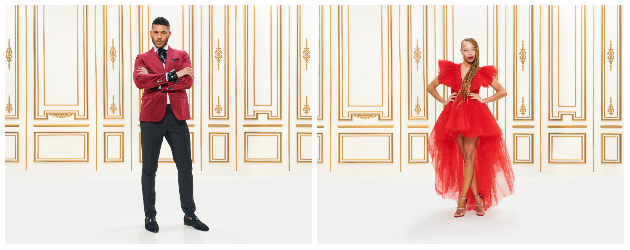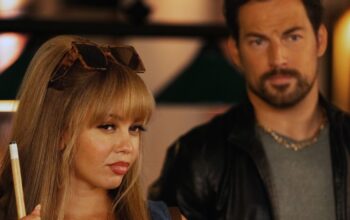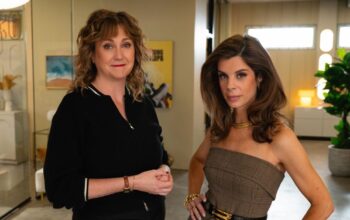Canada, start your engines because tonight’s the premiere of Canada’s Drag Race! Earlier this week, we shared our conversation with RuPaul’s Drag Race alum and Canada’s Drag Race judge, Brooke Lynn Hytes, and now it’s time to chat with the other two judges, Jeffrey Bowyer-Chapman and Stacey McKenzie. Below is what they shared with me about the wisdom they brought to the show based on their own experiences, what sets Canadian drag queens apart from the rest, and how drag unites people of all backgrounds in their love of this art form.
Canada’s Drag Race premieres at 9pm ET on Crave.
Jeffrey, what were you able to bring to Canada’s Drag Race from your experience as a guest judge on the original series?
Jeffrey: I sat on the panel of RuPaul’s Drag Race as a guest judge three times and participated in challenges with the queens and with Ru. It gave me the golden ticket into the workroom and the mainstage. I soaked up every second that I spent on that set, having that experience and not taking it for granted. Stepping onto the Canada’s Drag Race set, I felt at home and I also knew my role. I was there for a reason: my years as a model and an actor, and working with talent scouts.
Spending so much time with RuPaul on [the Drag Race] set, I learned about the importance of authenticity, vulnerability and creating a safe space for others to thrive and bring their best selves. I also learned from Michelle Visage the importance of giving some tough love and being as incredibly honest and concise as you can be. At the end of the day, this is a competition. These queens are here to win a crown, the title of Canada’s First Drag Superstar, and $100,000.
Time goes by very quickly on that set. Although there are long days of filming, it goes by in the blink of an eye. As a guest judge, I absorbed every moment and took as much away from it as I could to learn and grow and evolve as a human being myself. That is what I passed along to the queens [on Canada’s Drag Race]. This is a once in a lifetime opportunity, so don’t sleep on it.
Stacey, with your extensive experience in the modelling and fashion world, what would you say are the main things you brought to the judges’ table?
Stacey: I brought forth what I’ve learned in the modelling world: runway, photo posing, and how to walk into a room and own it. I’m also a speaker, so that comes into play as well. The most important things that I love to bring to the queens are being confident within themselves, loving who they are, accepting who they are, not taking no for an answer, being ahead of the game, and knowing their craft inside and out.
How much did you know about the world of drag before joining Canada’s Drag Race?
Stacey: I originally got into drag going to the clubs in Toronto, like Crews and Tangos on Church Street. I started going there when I was 16. When I was pursuing modelling in New York, I met up with a really cool designer who was a club kid at the time, Richie Rich. And he introduced me to drag in New York. From there, I met and worked with Patricia Field [who] introduced me to the ball scene. I couldn’t resist that 100-foot runway, showing off and being very theatrical.
Would either of you say that Canadian drag queens have any distinguishing differences compared to drag queens in the US?
Stacey: The Canadian drag queens that I’ve met are definitely nicer. And it’s not so much of an ego thing with them. The queens that we worked with on the show were really hungry to learn, so they would humble themselves. Another thing is the diversity and the love of their cultures and ethnicities. They showcase that a lot and are very proud to be who they are. One particular competitor, Ilona Verley, is an indigenous drag queen which is so dope.
Jeffrey: I agree. Canada has a reputation for being quite apologetic, and our sense of humour and sarcasm can be quite self-deprecating. As much as that could be viewed as a potential negative, it does lend to what Stacey was saying. The egos weren’t as flared up as queens from other countries. They were they were humble. They were able to stand on the stage in celebration of themselves and still be able to hear our critiques and guidance, and not take it personally.
In regards to ethnic diversity, economic inequality is rampant, specifically among people of colour versus white people across the globe. That is true in Canada as well, but specifically in the United States. When it comes to people of colour and Black bodies, there’s a huge economic wealth gap that is intentional and systemic. So much of yourself goes into drag, your finances, and resources. Every dollar that a drag queen makes at a club or personal appearance goes back into their own drag. We often see the inequality of white queens who can afford more extravagant clothing, wigs, and makeup. They have accomplished designers create custom couture pieces for them. But so many queens of colour don’t have that opportunity. They don’t have their families to lean on or expendable income. Every dollar they make has to go to surviving.
While recognizing that economic inequality for people of colour is a real thing internationally as well in Canada, there are different levels. Seeing so many different queens from diverse backgrounds coming to the table, and the level of balance or equity on our show in that respect was refreshing.
Jeffrey, you touched on some of the challenges you were a part of on RuPaul’s Drag Race. Any chance we’ll see you in a challenge or two on Canada’s Drag Race?
Jeffrey: You’ll have to wait and see! It was one of my first requests as soon I was asked to do the show. In some Drag Race universe, I may or may not be reprising my role as The Bitchelor.
Drag has become a worldwide phenomenon thanks to the Drag Race franchise. It has brought people together far beyond the queer community because of their love for this art form. Do you have any thoughts you’d like to share on the unifying power of drag?
Jeffrey: My mother visited me in Los Angeles and came to her first RuPaul’s DragCon with me a few years ago. As a 60-year-old white woman from Alberta, Canada, she was blown away by the energy, joy, love and acceptance. She looked at me with tears in her eyes after being at the judges’ panel with me and said, “I have not felt so seen in such a long time. I feel like I’m invisible in the world sometimes. People don’t really pay attention or want to engage or have any genuine interest in who I am as a human being. Everybody here looked me straight in the eyes, smiled at me, gave me a hug, told me they love you, and they love me.”
It’s a beautiful celebration, and I remember her comment specifically on why that can’t be the case with heteronormative society at large. Why, in our community — a community of people who have been so oppressed and punished and abused for centuries — are we the ones who are still loving, accepting, open and welcoming to every walk of life when so often the heteronormative, cisgendered Caucasian status quo is the exact opposite. That’s something that that really stuck with me and made such an impact on me. And I don’t even know how to answer the question that she asked. How is it that we still have the love and light in our hearts to be open to everybody? I don’t know how we as the LGBTQ spectrum have managed to do that. But I think, as a community, it’s our superpower.
Stacey: That’s why I was drawn to the drag scene as well. Being different — different looking, sounding different — I was never accepted. When I attended a drag show and was around [this community], everyone was like, “You’re beautiful.” I was accepted in a way that I was never before. That’s really important because a lot of people are struggling with who they are and what they look like. It’s rare to come across people, especially a group of people that [welcomes you] with open arms. It would be great if the entire world could be like that.
My nephew didn’t “come out” to me, but he came out to me. And I was the one who took him to his first drag show. I saw the joy that it brought to him. I’d never seen him that happy in years, He was laughing and smiling and hugging me. Drag has the ability to touch the heart in a very positive way.
Photos Courtesy of Crave







